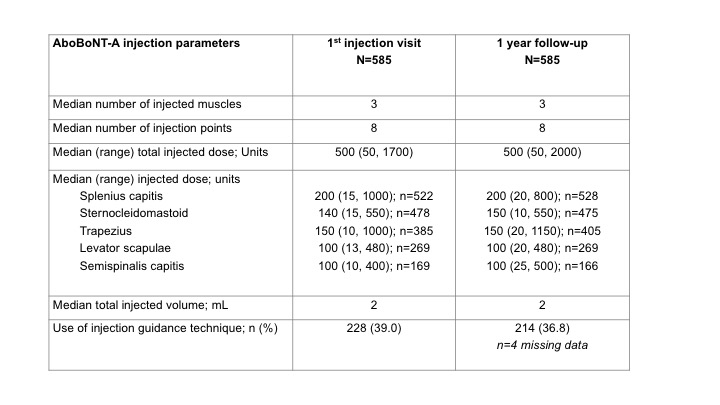Session Information
Date: Sunday, October 7, 2018
Session Title: Dystonia
Session Time: 1:45pm-3:15pm
Location: Hall 3FG
Objective: Evaluate the most common cervical dystonia (CD) patterns and injection practices for CD patients undergoing routine treatment with abobotulinumtoxinA (aboBoNT-A) over 1 year of follow-up.
Background: CD can involve a variety of abnormal head and neck patterns; it can be simple (1 pattern involved) or complex (>1 pattern involved). Treatment with botulinum toxin, including aboBoNT-A, should be tailored to individual patient presentations.
Methods: The MetaCD database includes data from 2 observational international studies (INTEREST IN CD1 [NCT00833196)] & INTEREST IN CD2 [NCT01753349]) and 1 USA registry (ANCHOR-CD [NCT01314365]). Here, we describe the patterns of CD and injection parameters in subjects routinely treated with aboBoNT-A over 1 year (N=585). Assessments were at baseline/first injection and at the 1-year visit.
Results: The most common CD patterns at baseline and 1-year were rotation (63.7%/65.6% of subjects, respectively) and laterocollis (26.1%/21.9%). Less than 10% subjects had retrocollis or anterocollis. About a quarter of subjects had a simple presentation (26.1%/26.0%), while complex presentations could include up to 5 combined patterns. Shoulder elevation (50.4%/55.3%), tremor (46.8%/48.3%) and jerk (11.0%/11.1%) were common components of the presentation. AboBoNT-A Injection parameters were in line with current recommendations for rotation and laterocollis, and remained stable over 1 year follow-up [table1]. The most commonly injected muscles were the splenius capitis (injected in 89.2%/90.3% subjects), sternocleidomastoid (81.7%/81.2%), trapezius (65.8%/69.7%), levator scapulae (46%/46.3%) and semispinalis capitis (28.9%-28.6%).
Conclusions: These data indicate a stability of CD patterns and relevant injection parameters over 1 year of repeat treatment with aboBoNT-A. Basic injection training focusing on rotation and laterocollis should cover the needs of >80% of patients in routine practice. More complex patients can be referred for specialist treatment.
To cite this abstract in AMA style:
R. Trosch, V. Misra, S. Om, P. Maisonobe. Cervical dystonia presentation and associated injection practices for patients undergoing routine treatment with abobotulinumtoxinA over 1 year of follow-up [abstract]. Mov Disord. 2018; 33 (suppl 2). https://www.mdsabstracts.org/abstract/cervical-dystonia-presentation-and-associated-injection-practices-for-patients-undergoing-routine-treatment-with-abobotulinumtoxina-over-1-year-of-follow-up/. Accessed January 7, 2026.« Back to 2018 International Congress
MDS Abstracts - https://www.mdsabstracts.org/abstract/cervical-dystonia-presentation-and-associated-injection-practices-for-patients-undergoing-routine-treatment-with-abobotulinumtoxina-over-1-year-of-follow-up/

